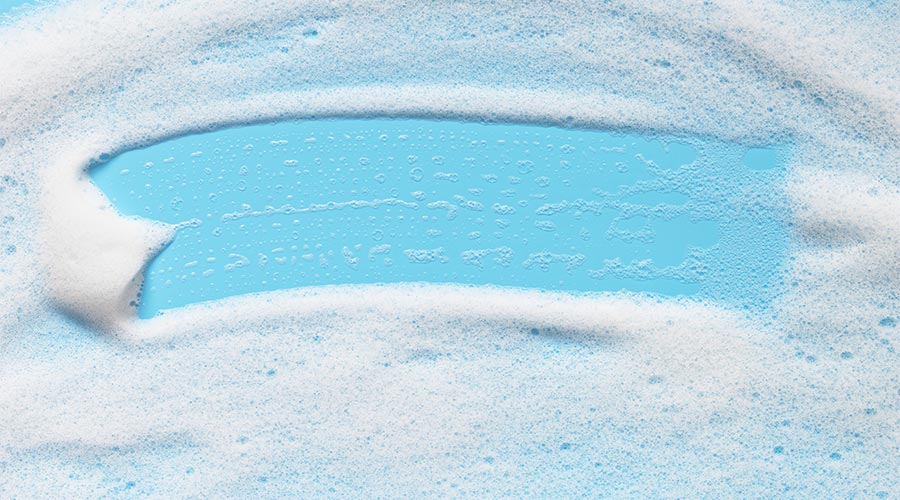
Surfactants have been around since the first Ancient Babylonian boiled fats with ashes and made soap. A lot has changed since then, but surfactants — a portmanteau of surface-active agents — remain a vital component in today’s cleaning chemicals. With a hydrophilic head that wants to be in water and a hydrophobic tail that doesn’t, these molecules form micelles that trap and hold dirt. Rinse and those dirt-filled micelles float away leaving a clean surface behind.
But what happens after those surfactants go down the drain?
Today, many modern surfactants are produced using non-renewable, petroleum-based materials. This is a problem according to Roger McFadden, chief science officer, McFadden and Associates, LLC, Canby, Oregon.
“Many synthetic surfactants have moderate to high levels of toxicity and poor biodegradability,” he says. “They can have a negative impact on wastewater treatment as well as aquatic microbial populations, fish, and other aquatic life.”
Enter bio-based surfactants. Made from readily renewable, plant-based materials, bio-based surfactants offer a reportedly safer and more sustainable alternative to non-renewable, petroleum-based surfactants. These chemicals minimize toxicity, maximize biodegradability, and reduce the environmental impact of their production and use without sacrificing product performance.
McFadden explains further, “Bio-based surfactants are typically derived from renewable sources such as plants, coconut, corn, and soybean oils. Bio-based and sugar-based surfactants, such as sorbitan esters, sucrose esters, alkyl polyglucosides, and fatty acid glucamides are gaining in popularity because of improved performance along with human health and environmental compatibility compared to traditional formulations.”
Experts express that bio-based surfactants can offer a big improvement over synthetic surfactants, but they are not perfect. Despite their name, the products are not always 100 percent bio-based, meaning they can be made, in part, from non-renewable raw materials. Also, the production of many bio-based surfactants requires the traditional, water- and energy-intensive chemical reactions in the manufacturing phase.
Still, the category continues to grow. Bio-based surfactants have already replaced many conventional, petroleum-based surfactants in cleaning products.
Part of the reason is because bio-based surfactants represent a good step forward in sustainability. However, some experts predict that microbial biosurfactants are the next frontier.
“Microbial biosurfactants are produced by readily renewable microorganisms and are 100 percent biobased,” says McFadden. “They are a type of bio-based surfactant produced naturally — often through fermentation.”
Surfactant Breakdown
Unfortunantely, some confusion persists between the terminology of bio-based surfactants and biosurfactants.
“It’s important to note that all biosurfactants are bio-based surfactants, but not all bio-based surfactants are biosurfactants,” says McFadden.
Be that as it may, bio-based surfactants and biosurfactants share many positive qualities. When it comes to cleaning formulations, both perform and act very much like their synthetic, petroleum-based counterparts. They also both minimize toxicity, maximize biodegradability, and reduce the carbon footprint when compared to surfactants made from petroleum products.
Although similar, microbial biosurfactants will edge out bio-based surfactants on several fronts. For example, biosurfactants come in all sorts of varieties. There are options that offer solubilizing, emulsifying, dispersing, detergent and stabilizing properties — and this allows cleaning teams to have plenty of options when picking the right product for the job.  Biosurfactants also function as high-performance surface-active agents and emulsifiers to remove soils, oils, and grease.
Products formulated with biosurfactants are versatile. They are highly effective and can be designed to work in cold or hot water, salt conditions, low or high pH, viscosity, or foam, compared with synthetic surfactants.
Another advantage, “biosurfactants are benign by design and therefore can be used on a wide variety of surfaces and soils without damage to surfaces or fixtures,” McFadden stresses.
Manufacturing biosurfactants is a highly efficient process with a small carbon footprint. Fermenting these chemicals requires less water, uses less energy, and produces less waste than creating synthetic or even bio-based surfactants. This makes biosurfactants a “greener” choice right from the start, a shift from the cleaning industry’s classic vision of an eco-friendly product.
“There is often too much attention given to the end-of-life of these products,” explains Steve Ashkin, President/Founder, The Ashkin Group, LLC, Channel Island Harbor, California. “Biosurfactants offer environmental and health benefits throughout their entire life cycle.”
Environmental advantages like these are one reason why the biosurfactants sector is gaining momentum from a market persepctive — which was valued at $1.2 billion in 2022 and is projected to reach $2.3 billion by 2028, according to Markets and Markets research. That growth is driven by demand from international governments and regulatory authorities for more sustainable products.
However, there is a downside. Manufacturing biosurfactants requires leading edge technology. This bumps their price higher than synthetic or even bio-based surfactants.
“These products are slowly making their way to the cleaning industry,” says Ashkin. “But right now, the biggest obstacle is cost.”
And cost, especially in the highly competitive cleaning industry, is a huge driver in buying decisions. This becomes truer when budget reductions are on the table.
“We need to dispel the myth that people will pay more for green products,” Ashkin continues. “Sure, there are industry leaders and early adopters that may pay for these products, but they only represent maybe 10 percent of the whole market.”
Good news is on the way for the other 90 percent. The cleaning sector is not the only industry that relies on surfactants. Agriculture, food processing, personal care products, pharmaceuticals, wastewater treatment, and even petroleum recovery also require surfactants. Demands in these large industries promise to attract more manufacturers into the biosurfactant space, eventually driving the price down for everyone, including cleaning product manufacturers. Meanwhile, McFadden urges patience.
“It will take some time, maybe three to five years, before we achieve cost parity,” he predicts.
How Details Make a Difference When Choosing Surfactants

 Celebrating BSCAI's 60th Anniversary eBook
Celebrating BSCAI's 60th Anniversary eBook The Down and Dirty on Cleaning in Virus Season
The Down and Dirty on Cleaning in Virus Season How Surfactant Use is Expanding in Commercial Cleaning
How Surfactant Use is Expanding in Commercial Cleaning